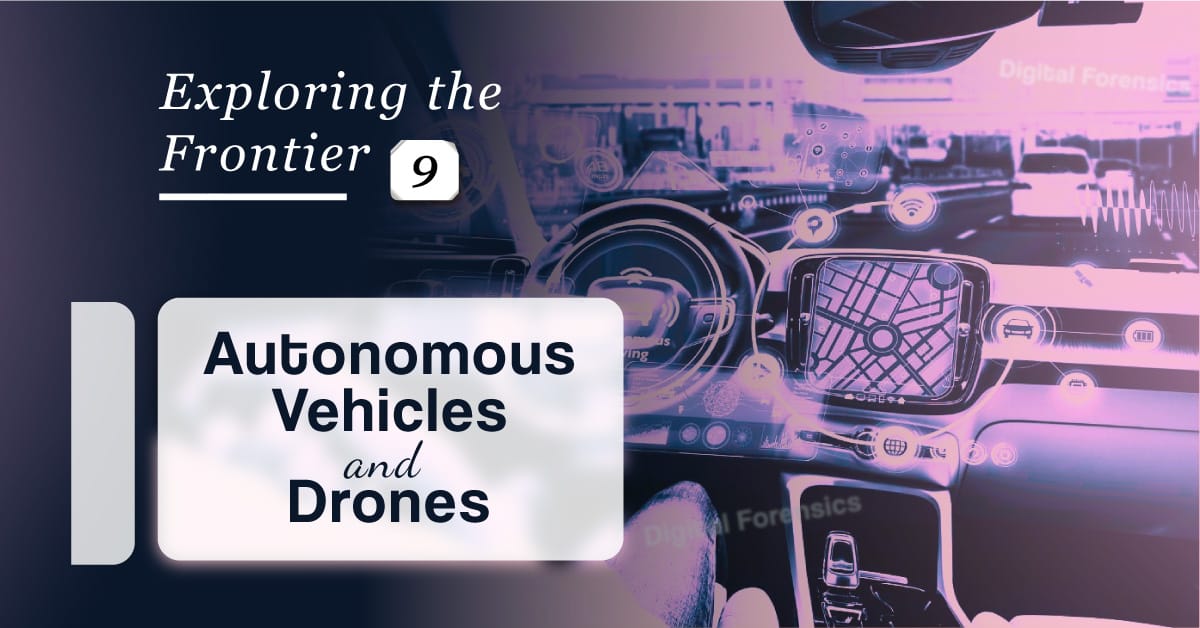Contributed by: Shari Onda, CFCE, GCFE, GISF, GASF, Forensic Analyst
9th in the series of the Top 10 Hottest Topics in Digital Forensics for 2024
The rise of autonomous technology is reshaping industries across the globe, from transportation and logistics to surveillance and law enforcement. As self-driving cars and drones become more prevalent, they bring with them a new set of challenges for digital forensics professionals. This technology generates vast amounts of data—vehicle telemetry, drone flight logs, sensor recordings, and even AI decision-making logs—that must be carefully analyzed in the event of accidents, crimes, or malfunctions.
As we continue our “Top 10 Hottest Topics in Digital Forensics for 2024” series, we focus on Autonomous Vehicles and Drones. This emerging area presents both exciting opportunities and complex challenges for digital forensics, requiring a deep understanding of how these technologies work and the data they produce.
Autonomous Vehicles: A Data Goldmine
Self-driving cars, or autonomous vehicles (AVs), are equipped with a suite of sensors, cameras, radar systems, and AI algorithms that allow them to navigate and make decisions in real-time. This continuous stream of data is crucial for understanding the vehicle’s performance, especially when things go wrong.
When an autonomous vehicle is involved in an accident or other incident, forensic experts must analyze its telemetry data, which includes:
– Speed and acceleration at the time of the incident
– Braking patterns and whether the vehicle attempted to avoid a collision
– Steering inputs to determine if the vehicle or driver attempted any evasive maneuvers
– Sensor data from cameras, radar, and LiDAR to identify what the vehicle “saw” and how it interpreted its surroundings
– AI decision logs detailing how the vehicle’s onboard systems processed this data and made driving decisions
This wealth of data provides a comprehensive view of what happened during an incident, but it also requires advanced analytical tools to sift through and interpret the information accurately. For example, forensic experts must understand the underlying algorithms that govern the vehicle’s decision-making to determine whether the system functioned as intended or if a flaw contributed to the incident.
Additionally, legal questions arise regarding liability. In an accident involving an autonomous vehicle, determining fault is often more complex than in a traditional accident. Was the vehicle at fault, or did human error (such as failing to maintain the system properly) contribute to the incident? As autonomous technology becomes more widespread, forensic experts will need to stay updated on the evolving regulations governing these technologies.
Drones: From Surveillance to Delivery
Drones are another rapidly advancing technology with far-reaching implications for digital forensics. Once the domain of hobbyists, drones are now widely used for commercial purposes, such as delivering packages, conducting aerial surveillance, or providing disaster relief in remote areas.
In forensic investigations, drones can be both witnesses and subjects. For example, in a crime scene, drone footage might capture critical evidence that would otherwise be difficult or impossible to obtain from the ground. Conversely, drones themselves may be involved in criminal activities, such as illegal surveillance or smuggling.
When analyzing drone-related incidents, forensic experts typically focus on:
– Flight logs, which include data on the drone’s altitude, speed, and flight path
– GPS coordinates to trace where the drone has been and whether it was operating within legal airspace
– Sensor and camera recordings, providing visual evidence that can either support or refute claims
– Communication logs, which track signals between the drone and its operator, revealing who was in control of the device at the time of the incident
Much like autonomous vehicles, drones present challenges around data integrity. Forensic experts must ensure that flight logs and other data haven’t been tampered with, as cybercriminals might attempt to manipulate or erase incriminating evidence.
Incident Scenarios Involving Autonomous Vehicles and Drones
Incorporating autonomous vehicles and drones into forensic investigations opens up a wide range of potential scenarios, including:
- Traffic Accidents Involving Self-Driving Cars: Forensic experts can use telemetry data to reconstruct the sequence of events and determine whether the car’s systems were functioning properly. This analysis might reveal whether a malfunction in the car’s AI system, environmental conditions, or human intervention caused the crash.
- Drone Misuse and Privacy Violations: Drones equipped with high-definition cameras can capture sensitive or private information. Forensic experts may be called upon to analyze drone data to determine whether privacy laws were violated, such as in cases of unauthorized surveillance or illegal drone flights over restricted areas.
- Criminal Activities Using Autonomous Technology: Autonomous vehicles and drones could be used to carry out illegal activities, such as transporting contraband or evading law enforcement. In these cases, forensic professionals must analyze the vehicle or drone’s data to trace its origins, identify the operator, and uncover evidence of the crime.
- Cyberattacks on Autonomous Systems: As self-driving cars and drones become more connected, they also become targets for hackers. A cyberattack on an autonomous vehicle could cause it to malfunction or be used as a tool for criminal purposes. Forensic experts must analyze both the vehicle’s data and any external communications to determine if a hack was involved and trace the attacker’s digital footprint.
Legal and Ethical Implications
The introduction of autonomous vehicles and drones raises significant legal and ethical questions, particularly around accountability and privacy. For example, in an autonomous vehicle accident, who is liable—the manufacturer, the software developer, or the operator? Additionally, drones used for surveillance may infringe on individuals’ privacy rights, leading to complex legal challenges regarding the admissibility of drone-captured evidence.
Forensic experts working with autonomous technology must be aware of the latest laws and regulations to ensure that their analyses are legally sound and ethical. They must also work closely with legal teams to ensure that the evidence they collect is admissible in court and properly handled to avoid tampering or contamination.
The Future of Autonomous Forensics
As the use of autonomous vehicles and drones continues to expand, forensic experts must adapt their methods to keep up with the growing volume and complexity of data. This includes investing in new tools and technologies for analyzing sensor data, AI decision logs, and other forms of digital evidence. Additionally, collaboration between forensic experts, software engineers, and legal professionals will be crucial to developing best practices for handling autonomous technology in forensic investigations.
Conclusion
Autonomous vehicles and drones represent the cutting edge of technological innovation, but they also present new challenges for forensic investigations. Forensic experts must stay ahead of the curve by understanding how these systems work, what data they generate, and how to analyze it effectively. By doing so, they can provide critical insights into incidents involving autonomous technology, ensuring justice and accountability in an increasingly automated world.







